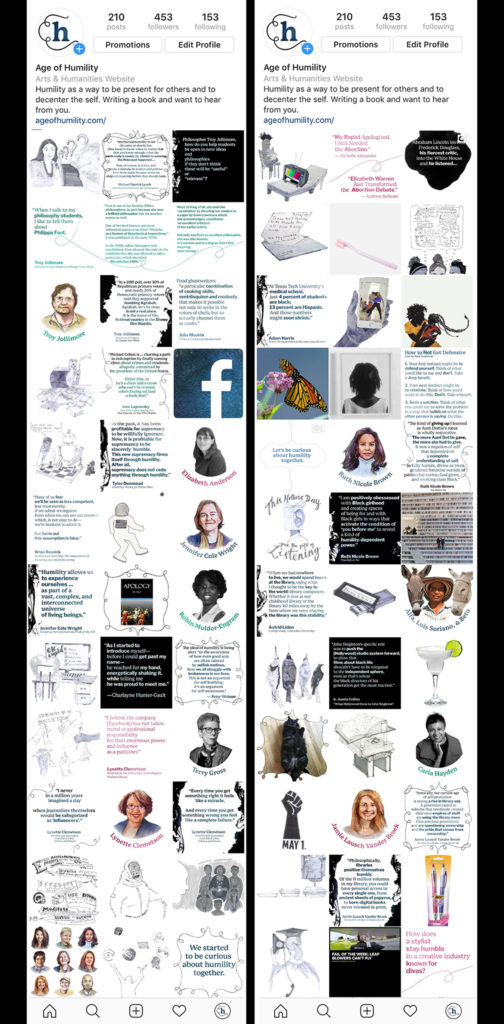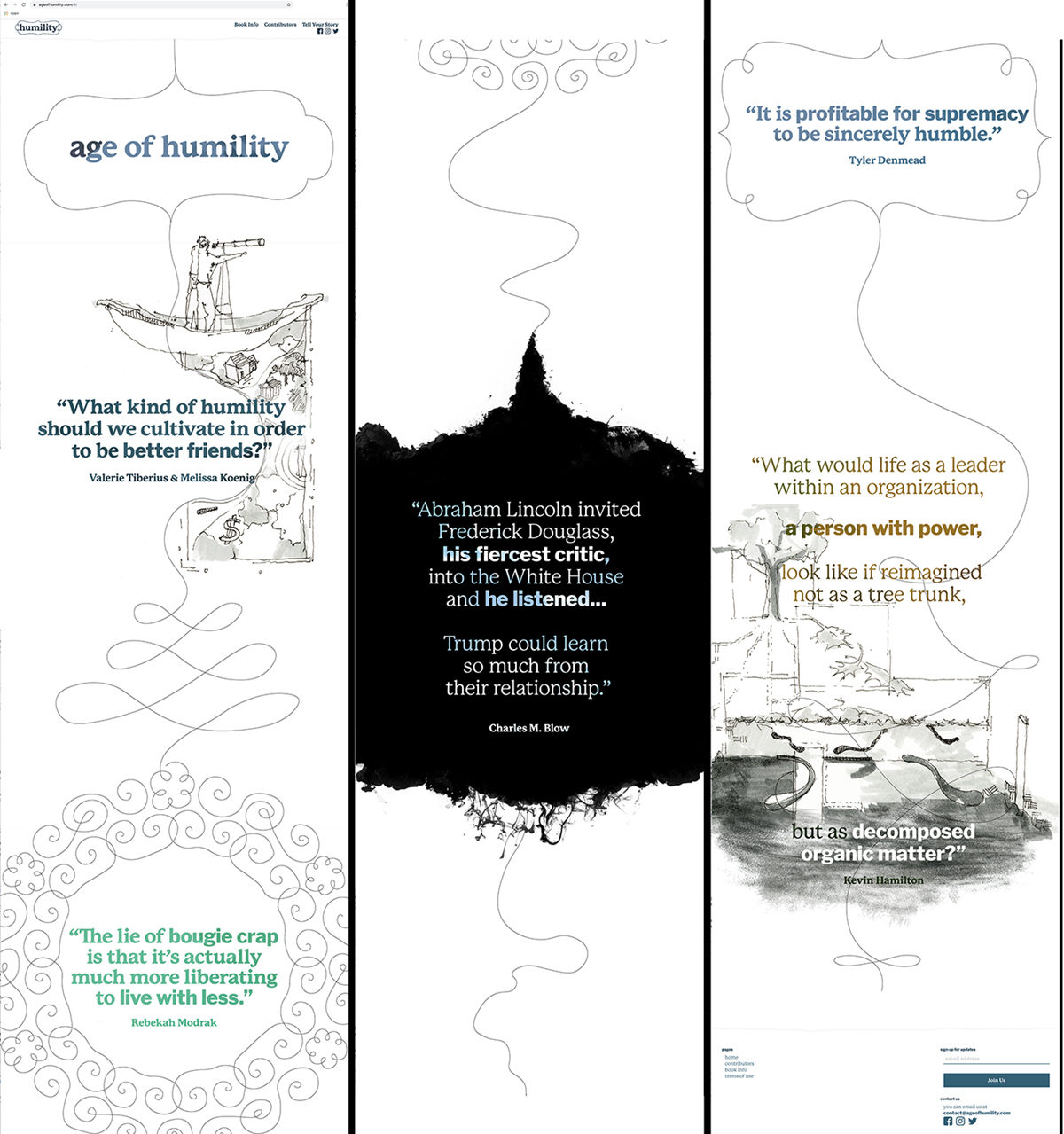Design Team
Rebekah Modrak, Professor, University of Michigan
Jamie Lausch Vander Broek, Librarian, University of Michigan
Sam Oliver, Designer, Shaper Realities
The Age of Humility project asks: can we reinvigorate humility from seeming like an archaic virtue studied by scholars and clergy to a living value, practiced in every workplace, from hospitals to courtrooms, and relevant in all realms, informing our choices as friends, colleagues, parents, and citizens? This project involves multiple work products—from a collection of essays to a series of researched posts distributed via social media—all with a centralized base: the Age of Humility website (AgeOfHumility.com). In designing the website and social media pages, our goal was to support the project and to inspire interest in humility as a value during this time in which political boasting and status-seeking are pervasive, and humility is rarely discussed.
In designing AgeOfHumility.com, we understood that exploring humility through scholarly research and anecdotal/personal narrative would not be served well by the current commerce-based paradigm for web design, which emphasizes self-promotion and facile consumption of information. Literary promotional websites, by default, have a self-congratulatory aesthetic. Their goal is to impress visitors. Critics’ praise, flattering headshots, and authors’ accolades take center stage in an effort to persuade would-be readers into making a purchase. We wanted to design an alternate approach.
We entered into the design process with several questions:
- If humility involves a capacity to acknowledge error and learn new perspectives, how can the website design communicate and enact this openness to change?
- How do we encourage users to see our contributors as an extension of their own community, and how can we prioritize ideas rather than promote people?
- Can we approach web design in such a way that we encourage users to slow down and take time processing complex insights about humility?
Using a collaborative process, we developed several design strategies meant to engage visitors in conversation:
- The meandering line — a line of curiosity that leads users from thought to thought.
- The hand-drawn curlicue frame — a momentary pause to consider an idea or image.
- The gradient — communicating the fallibility of represented perspectives.
- The animated ink cloud / moving field of pigment — indicating that thought is not static. The ink cloud also conveys emotional content to indicate elation or turbulence.
All elements mimic organic movement to defy the flat space of the digital screen and the grid-based template of much web design.

The Age of Humility website and social media use this visual language to create contemplative space within a traditionally fast medium. The home page introduces viewers to diverse dialogues around humility. We intentionally avoid the primacy of the cursor’s point-and-click as the method of interaction. Instead, the main activator on the site is the imperfect, hand-drawn winding line that coils around quotations and entices users to scroll down the page, reading ideas that come politics, consumer culture, psychology, and other perspectives. The line and animated ink cloud all indicate that thoughts are pliant and yielding and prompt an introspective, gentle tempo for navigating the site. We use two complimentary fonts filled with a watercolor texture as a way of implying a spoken voice that fluctuates in timbre, and as a means to emphasize key words within that speech. The home page uses these designed tools to emphasize thoughts about humility rather than specific people.
The site’s navigation menu leads users to the contributors page where we replaced the traditional headshots with watercolor portraits so that contributors are seen as approachable, and to convey the idiosyncratic nature of the project. The watercolor medium treats contributors as characters on the page within a book of tales about morality and ethics. None is more important than another and, collectively, they build a broad, diverse understanding of humility. On the individual profile pages, we again emphasized excerpts and perspectives over biographies.
As contemporary social media is synonymous with self-promotion, Instagram presented a more severe set of challenges. We designed a strategy here of featuring one discipline or perspective for a two-week sequence of posts. For example, humility and mathematics; humility and Black girlhood; humility and aging. Working with two-week increments, we developed the website’s toolkit to be dynamic and compelling for fourteen days. We developed multiple variations of hand-drawn coiling frames and ink clouds. The hand-drawn curlicue frame transferred well to social media, providing a recognizable and consistent hallmark and a border for logos, photographs and other content that we want to absorb onto our site. We extended the hand-drawn meandering line into fully drawn illustrations; each two weeks of content are illustrated by five or six whimsical drawings, rendered carefully but without hard lines. The color watercolor portrait of the contributor who has inspired the series begins each two-week period. And because putting a face to people is so important to us, we create black-and-white portraits of guest social media contributors as a way to distinguish them from long-term contributors.
The resulting Age of Humility website and social media sites avoid the tropes of vanity websites and become both a preface for and visual extension of our exploration of humility. The site launched in January 2019 and we are excited to note that the audience is growing every day, both through the mailing list and social media. We’ve just passed 4500 followers on Facebook. After viewing the Age of Humility sites, the literary agency Dunow, Carlson & Lerner offered us a contract to represent our forthcoming book, citing the compelling way we’ve created a conversation around humility on the website and social media. Most importantly, the site has set up a platform for us to connect with communities across the world. We recently hosted a week-long series about humility from the perspective of residents of Ishinomaki, Japan; we partnered with author Rob Walker for a series of joint posts in which our contributors commented on excerpts from his book Art of Noticing; and we provided a forum for artists working on issues of free speech and democracy to share their work.
Age of Humility website: https://ageofhumility.com/#/
Age of Humility on Instagram: https://www.instagram.com/ageofhumility/
Rebekah Modrak
Rebekah Modrak is an artist and writer who practices at the intersections of art, activism, discursive design, and creative resistance to consumer culture. Her net-based artworks critique brand appropriation. Re Made Co. (remadeco.org) takes the form of an online “company” to parody actual company Best Made Co.’s appropriation of working-class imagery and values for leisure consumption. Rethink Shinola analyzes a complex and patronizing agenda of marketing the White savior myth. Modrak’s writing, published in such journals and books as Consumption Markets & Culture and Afterimage, analyzes the links between design, education, and brand marketing. For the past three years, she co-built and directed the site Age of Humility, bringing together dozens of diverse participants representing fields such as philosophy, the arts, law, race theory, and business, to reflect upon humility. Rebekah is a professor at the Stamps School of Art & Design at University of Michigan.
Jamie Lausch Vander Broek
Jamie Lausch Vander Broek is a Librarian for Art & Design at the University of Michigan. This summer, she bought a book made of cheese for her library. You can read about it on saveur.com [https://www.saveur.com/cheese-book-university-of-michigan]. She holds a tailored Master’s degree from the U-M School of Information in Art and Art Museum Librarianship, and received a B.A. in Art History with a minor in Italian Studies from Wellesley College. Since arriving in Ann Arbor, she has been active in the local art and book communities, and is currently on the board of the Ann Arbor District Library.
Sam Oliver
Sam Oliver is the founder of Shaper Realities, a product and interaction design studio based in Brooklyn. He founded the studio as a rebuke to the industry standard separation of design and development. Shaper Realities strives to combine the two practices within a single process. The members of the studio are all technical, and have ownership of projects from conception through launch. The studio works primarily with startups using bleeding edge technologies and artists reimagining the future implications.
Outside of his studio practice Sam Oliver remains an active part of the Hacker community. He believes strongly in the virtues of creative ownership within any maker practice, and works within the community to promote whimsical, non-commercial applications of technology.
Recipient of recognition in the Design Incubation Communication Design Awards 2019.
